
Fishguard & Goodwick Station Gallery 11 1 August 1899 - c1950 old18.jpg) Goodwick station on 1 August 1899, the opening day. At this time the station had only one platform. Note the building at the north end of the station building has not yet been constructed. The locomotive on the right looks suspiciously like a Manning Wardle K class 0-6-0 saddle tank and would have belonged to the contractor. On the left near the white gates is either a steam traction engine or roller; it is probably a roller doing some last-minute work.
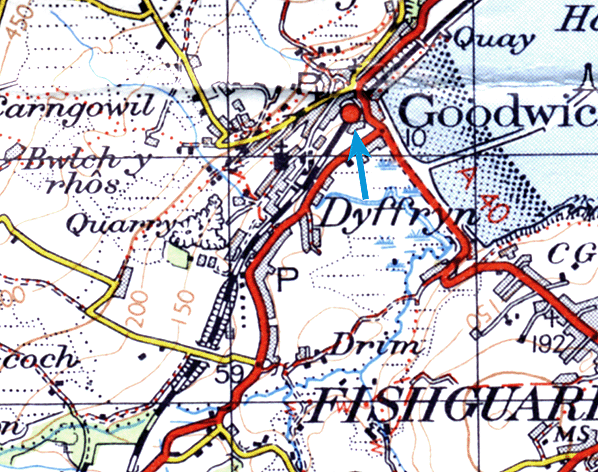 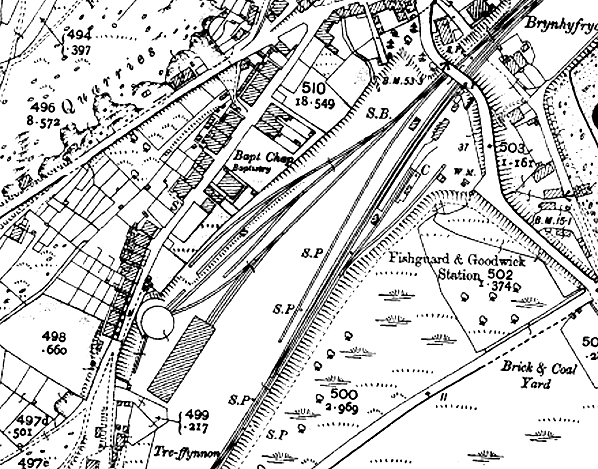
1908 1:2,500 OS map shows Fishguard & Goodwick station shortly after the line was extended to Fishguard Harbour. At this time the line was single track with one platform. The signal box is seen opposite the north end of the platform. The 2-road engine shed to the west of the station was opened by the GWR in 1906. The small goods yard is seen to the east of the station with a goods dock behind the platform. A 1-ton 10-cwt capacity crane stands on the dock. A signal box stands opposite the station alongside the shed line.
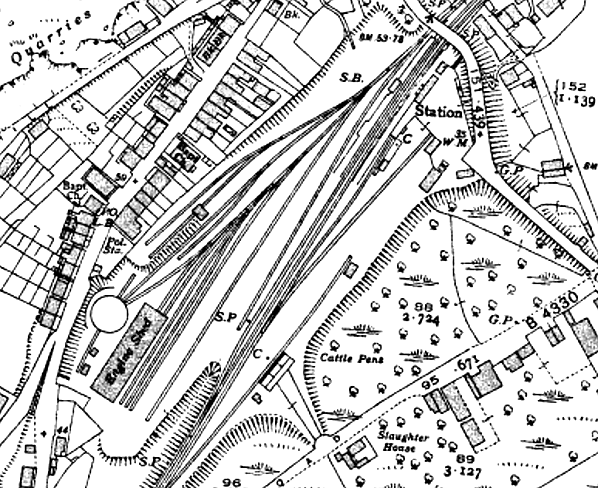
1937 1:2,500 OS map. By this time a second platform had been added; the original signal box has been retained with the second platform being built round it. A third siding has been added to the goods yard serving a cattle dock and pens. The entrance for livestock is in Wern Road; note the slaughter house opposite the entrance. A second crane stands nearby. A number of additional sidings have been provided to the east of the engine shed. Note that the station building is also longer with another building at the north end.
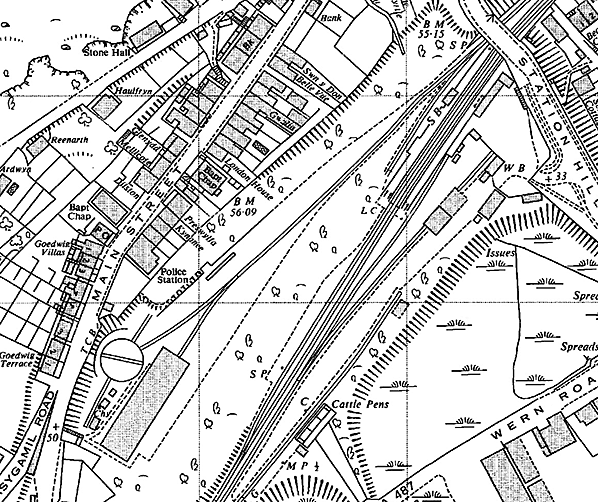
1965 1:2,500 OS map. The track layout at the engine shed has been simplified: all the sidings, including that serving the coaling stage, have gone apart from a single siding running into the engine shed and another running onto the terminal. The shed was closed by this date. The layout of the goods yard remains much the same although a goods shed has been added with one of the sidings now running through it. Note the level crossing (LC) shown at the south end of the platforms; this is, in fact, a barrow crossing and was the only way passengers could reach the down platform. The building at the north end of the up platform seen on the 1937 map above has been replaced by another building at right angles to the station building. This is now the only surviving building at the reopened station.
and_goodwick_old29.jpg) Fishguard & Goodwick station on Monday 30 August 1909, the late summer bank holiday seen from the top of the steps down to the station forecourt from Station Road. The razzmatazz is due to the calling of the Cunard liner RMS ‘Mauretania’, a symbolic gesture to publicise the new Ocean Mails transatlantic route in conjunction with the Great Western Railway. The regular vessels were RMS ‘Mauretania’ and the ill-fated RMS ‘Lusitania’, followed later by RMS ‘Aquitania’. These vessels, then, sailed from Liverpool and called at Queenstown in addition. Vessels of such size could not dock at small ports such as Fishguard, Queenstown and Cherbourg so anchored offshore and transfer of passengers and mails was by tender. Fishguard was apparently used only to disembark incoming passengers and mails, which could be in London long before the ship had even docked at Liverpool. Fishguard Port, actually located at Goodwick, had opened exactly three years earlier and was, of course, the port for the GWR's own steamer service to Rosslare, today operated by Stena Line. GWR stock used on the Ocean Mails service was branded 'Ocean Mails', with the 's', and is not to be confused with the famous Ocean Saloons which were associated with the Plymouth route. The Fishguard service was to be short-lived however, as Cunard switched its operations from Liverpool to Southampton after the First World War. RMS ‘Mauretania’ continued in service until September 1934 when she was laid up alongside RMS ‘Olympic’, both vessels then being stripped of fitting and furnishings for sale by auction. ‘Mauretania’ then sailed to Rosyth for scrapping on 1 July 1935. Aboard her on that final sailing should have been one of her former masters, Captain Arthur Rostron, but at the last minute Captain Rostron, by then a retired commodore, chose not to board saying he preferred to remember the ship as she had been. Arthur Rostron was master of RMS ‘Carpathia’ when she rescued survivors of the RMS ‘Titanic’ disaster back in April 1912.
Copyright photo from John Alsop collection and_goodwick_old27.jpg)
Fishguard & Goodwick looking south-west, seen from Station Road bridge c1910. The single-storey station building incorporated booking office, waiting rooms and toilets. The goods yard is at the rear of the up platform and two vans are seen standing at a dock on the left. The yard crane can just be made out on the end of the dock. Beyond the station on the down side is the large 2-road brick Churchward engine shed. Note that the windows on the signal box are at platform level when the box was in place but there was no platform; when the second platform was added in 1907 it was built round the existing box. The two buildings in the foreground were later replaced by a brick building at right angles to the main station building.
Copyright photo from John Alsop collection and_goodwick_old25.jpg)
A view eastwards over Fishguard & Goodwick station and what was to have been Fishguard Harbour in the first decade of the twentieth century. The houses in the right background are part of Fishguard itself, with Goodwick being to the left foreground. A number of houses had been constructed for railway workers. At the station can be seen a selection of typical period wagons. One, at the end of the easternmost siding, has either a pitched roof like a salt or loco sand wagon or is a tarpaulin wagon. At the bottom of the picture is a flat wagon loaded with what appear to be sections of pipe and with it are two GWR horseboxes. Of these two, that on the left looks like a Diagram N6 type. These were more 'boxy' and lacked the body tumblehome of the rather quaint-looking Diagram N5 types. The other horsebox is of a type (Diagram unknown) which had an open platform on one end. This platform is thought to have been for strapping on bundles of hay (horse fodder). These horseboxes would have been passenger-rated, meaning they could be attached to passenger trains, and thus would have been in brown livery. Further towards the right, and only partly in the picture, is what looks like a 4-wheel brake third. The most interesting part of this picture is the under-construction harbour and east (Parrog) breakwater, together with the railway seen crossing a bridge. What we are seeing is what would have been Fishguard Harbour, of which both it and the breakwater were never completed to their intended extent. Even from this picture and charts of the time it is fairly obvious that silting would be a problem. Indeed this was apparently obvious to everybody, including the local population, apart from the engineer who, it is said, was ultimately to hang himself. The problem of silting is said to have been made worse by construction of the breakwater and continual dredging could not win the battle against nature. The harbour and breakwater, of which the latter never reached its intended length, were ultimately abandoned and replaced by the present harbour and quay at Goodwick, the railway station there being opened in 1906. The scene resembles of modern Freightliner terminal. What looks like gantry cranes are in fact travelling gantries with conventional cranes mounted upon them while what looks like stacked containers are wooden crates; a common method of transporting goods at the time and the forerunners of today's container systems. Construction trains can be seen - just. There is one at the shoreline with a locomotive at its far end and another on the breakwater, far left. Of particular interest is the railway in the background, approaching on an embankment before crossing the road on a girder bridge and continuing onto the breakwater. This line was intended to counter severe gradients on the existing line to Fishguard and was known as the 'New Line'. The GWR, however, referred to it as the 'New Up Line', the implication being that the two routes from Letterston Junction were to be worked as up and down lines but, for reasons which will become clear, this has never been confirmed. The New Line had been authorised in 1903 with construction beginning sometime around 1906. The route ran to the east of the present line until Manorowen where it was to have entered two tunnels, of which one would have been quite long, which took the line beneath and west of the existing line before emerging again on its east side. The New Line would then have junctioned with the existing line just north of Letterston Junction. There was a connection with the existing line just south of Fishguard & Goodwick station, points facing in the up direction, apparently to allow delivery of construction materials. Track on the New Line was laid for about one mile and ended at a point near Dyffryn. The remainder of the line to Letterston Junction was never completed and the tunnels near Manorowen never constructed - or at least never completed. Of the track which was laid, this seems to have been lifted by the 1930s if not earlier. Today the breakwater remains but the port area seen above is now partly landscaped and partly used for car parking. It is known as The Parrog. An wooded patch of land on the north side of the road marks the site of the former railway embankment but there is no trace of the bridge while the embankment south of the bridge has been obliterated. From Dyffryn southwards, however, much of the course of the unfinished railway can still be traced while just south of Dyffryn a stone bridge carrying a minor road over the line still stands.
Click here for a larger version. Photo from John Mann collection and_goodwick_old32.jpg) Fishguard Goodwick, as it came to be known, locomotive shed in 1921. On the right is the locomotive coaling stage which incorporated the water tower for supplying the water column seen here near the turntable. Transfer of coal from wagons to locomotives was by means of a hand-propelled narrow gauge tub, visible in this view. The photograph appears to have been deliberately posed, normal for the time, as the man pushing the coal tub and the crew of the tender locomotive, which is not positioned correctly for taking on coal, are all looking towards the camera. The locomotive is a ‘Saint’ class 4-6-0 while behind it and half out of the picture is what looks like a 517 class 0-4-2T. The open wagon to the left of the Saint was probably for ash removal. Reasonably visible is the locomotive turntable but what is positioned on it is hard to determine. Fishguard Goodwick's turntable, said to be of 60ft diameter, was of the 'over girder' type, meaning the girders were above the deck as can be seen here. There two types of over girder turntable, one with curved-top girders and, as here, one with angular-topped girders. They were a product of Messrs. Ransomes & Rapier. The 4-6-0 tender locomotives found at Fishguard & Goodwick were all longer over buffers than the turntable but with a wheelbase of eight to ten feet less, depending upon class, all could be accommodated on the turntable. The Saints were a species of the 2900 class, other species being the Scotts, Ladies and Courts. None of the 2900 class survived the scrapyard but preservationists are back-converting a Hall class, No.4942, into an example which will appear not as a Saint but as No.2999 ‘Lady of Legend’. The 517 class, on the assumption that is what is visible, became extinct in 1945. They had been intended for the Birmingham and Wolverhampton area but the 156-strong class soon swarmed all over the GWR system. Possibly the best known example was No.1473, named ‘Fair Rosamund’ in 1898 for working a Royal Train on Woodstock branch - the line on which she subsequently became the regular locomotive.
Photo from Roger Griffiths collection and_goodwick_old29.jpg) An aerial view over Fishguard harbour in 1929 showing, bottom left, Fishguard & Goodwick station and, towards top left, Fishguard Harbour station. The cottages on the left and above the railway are part of the Harbour Village, erected for the men (and their families) working on harbour construction. Similar provision was made at Fishguard, to the right and out of view, but apparently for railway workers. All land visible in this view is actually Goodwick. At the top of the picture is the North, or Pen Cw Breakwater, around 850m long and with a lighthouse at its extremity. This once had a railway track, leading from Harbour station, which approached the breakwater on a sharp curve. Its purpose was the loading of munitions onto naval vessels. At the bottom of the picture is the site of the original Fishguard port, its travelling gantries with cranes perched on top having long gone. Similar gantries and cranes could be found at the new port and in all probability were the same ones relocated. On the right is the East Breakwater. Below it, on The Parrog (Promenade), an abutment of the bridge which had carried the only completed part of the New Line to the breakwater can be seen*. This line was reached via a spur from the original line, the site of the spur being off the picture at bottom left. Inland of the former bridge can be seen part of the embankment which took the line south towards Dyffryn and where the track which had been laid ended. Maps from the 1930s show this embankment in situ but the nothing south of it until Dyffryn where earthworks reappeared and remain to this day. The East Breakwater, which was never built to its intended length, also had a light, referred to today as the Light Centre.[ *It remains unclear if the standard gauge New Line actually continued onto the breakwater or if there was some kind of transhipment point from which materials were taken onto the breakwater by narrow gauge railway. The apparent difference in levels between embankment and breakwater would suggest the latter. Click here for a larger version.
Copyright photo from Britain From Above old15.jpg)
Looking south at Fishguard & Goodwick station from the hillside above the town circa 1930s. The station is on the left with the goods yard behind the down platform. On the right the large Churchward engine shed and sidings are seen and the turntable can just be made out to its right.
Photo from John Mann collection old16.jpg) A Collett 1400, originally 4800, class 0-4-2T at Fishguard & Goodwick. No. 1423 was a long-time resident of Fishguard shed where she remained until January 1959, after which she moved to Oswestry before withdrawal later that same year. She is working with the same type of auto-trailer as seen in the picture of No.1431 (below) but this example is in carmine and cream livery. The date of this view is unknown but the lamp adjacent to the running-in board offers a clue. As yet it does not bear a BR totem (despite its position it later did) so a likely date is 1950 (when BR locomotive shedplates were introduced) to 1955.
Photo from John Mann collection
 Home Page Home Page
|

 Notes: The station was the planned terminus of the Rosebush & Fishguard Railway. Complications meant that, despite work having begun at Rosebush in 1878, the line was not completed by 1898 when the company (now called the North Pembrokeshire & Fishguard Railway) was purchased by the Great Western Railway Company. It is likely that this takeover was prompted by the North Pembrokeshire & Fishguard Railway's plans for a harbour at Goodwick to attract Irish traffic (the GWR had a major such port at Neyland) and/or their ambitious plan to link this new harbour to Carmarthen with their own line to break the GWR's monopoly of rail lines into west Wales.
Notes: The station was the planned terminus of the Rosebush & Fishguard Railway. Complications meant that, despite work having begun at Rosebush in 1878, the line was not completed by 1898 when the company (now called the North Pembrokeshire & Fishguard Railway) was purchased by the Great Western Railway Company. It is likely that this takeover was prompted by the North Pembrokeshire & Fishguard Railway's plans for a harbour at Goodwick to attract Irish traffic (the GWR had a major such port at Neyland) and/or their ambitious plan to link this new harbour to Carmarthen with their own line to break the GWR's monopoly of rail lines into west Wales.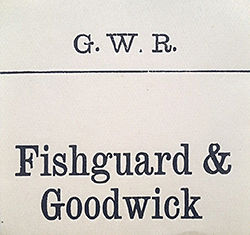 There was a small goods yard with two sidings, one of which served a loading dock behind the platform. A 1-ton 10-cwt capacity crane stood on the dock. At a later date, the yard was extended with the addition of a third siding serving a cattle dock and pens. A goods shed and a second 6-ton capacity crane were also provided. A standard 2-road Churchward engine shed with a 60ft turntable alongside was opened by the GWR on the down side of the line on 30 August 1906. There was a coaling stage with a water tank on top south of the shed; watering facilities were provided at the shed and on the platform. The first allocation of locomotives included three double-framed 'Bulldog' Class 4-4- the remainder were saddle tank engines, 16 locomotives in total. Access to both the shed sidings and the 0s; goods yard was controlled by a 37-lever signal box opposite the platform which opened on 29 July 1906 when the line was extended.
There was a small goods yard with two sidings, one of which served a loading dock behind the platform. A 1-ton 10-cwt capacity crane stood on the dock. At a later date, the yard was extended with the addition of a third siding serving a cattle dock and pens. A goods shed and a second 6-ton capacity crane were also provided. A standard 2-road Churchward engine shed with a 60ft turntable alongside was opened by the GWR on the down side of the line on 30 August 1906. There was a coaling stage with a water tank on top south of the shed; watering facilities were provided at the shed and on the platform. The first allocation of locomotives included three double-framed 'Bulldog' Class 4-4- the remainder were saddle tank engines, 16 locomotives in total. Access to both the shed sidings and the 0s; goods yard was controlled by a 37-lever signal box opposite the platform which opened on 29 July 1906 when the line was extended. 
 After closure to passengers the station remained open for goods traffic. From 18 June 1965 it became the terminus of a seasonal ‘Motorail’ service from London, the end-loading dock behind the former main (up side) platform being used for unloading the cars. A new 53-lever frame from Port Talbot Middle box was installed in the signal box in May 1965 to control the new Motorail sidings. During the early 1970s the station buildings were renovated, and new 'corporate identity' signage was installed. Motorail kept the station in use each summer season until the regular service ended on 19 September 1980 and the occasional peak service on 16 September 1982. Fishguard & Goodwick signal box closed on the 26 June 1983. Following the demise of the Motorail service the line was singled and realigned and the down platform was demolished.
After closure to passengers the station remained open for goods traffic. From 18 June 1965 it became the terminus of a seasonal ‘Motorail’ service from London, the end-loading dock behind the former main (up side) platform being used for unloading the cars. A new 53-lever frame from Port Talbot Middle box was installed in the signal box in May 1965 to control the new Motorail sidings. During the early 1970s the station buildings were renovated, and new 'corporate identity' signage was installed. Motorail kept the station in use each summer season until the regular service ended on 19 September 1980 and the occasional peak service on 16 September 1982. Fishguard & Goodwick signal box closed on the 26 June 1983. Following the demise of the Motorail service the line was singled and realigned and the down platform was demolished. 
 In March 2011, it was announced that Welsh Assembly Government subsidy would be provided to allow an increase in train frequency on the Fishguard line from two trains per day to seven from 12 September 2011 for three years. This prompted a search for funding to reopen Fishguard & Goodwick station; funding was successfully found and it was announced that the station was to reopen on 14 March 2012.
In March 2011, it was announced that Welsh Assembly Government subsidy would be provided to allow an increase in train frequency on the Fishguard line from two trains per day to seven from 12 September 2011 for three years. This prompted a search for funding to reopen Fishguard & Goodwick station; funding was successfully found and it was announced that the station was to reopen on 14 March 2012. The work to reopen the station was a joint operation between Pembrokeshire County Council and Network Rail. In March 2012, Network Rail announced that the station would reopen on 14 May 2012 and would be served by the seven trains each way per day which currently run through the station. The station duly reopened on 14 May. It was adopted under Arriva's ‘adopt-a-station’ scheme by the local community group, Point.
The work to reopen the station was a joint operation between Pembrokeshire County Council and Network Rail. In March 2012, Network Rail announced that the station would reopen on 14 May 2012 and would be served by the seven trains each way per day which currently run through the station. The station duly reopened on 14 May. It was adopted under Arriva's ‘adopt-a-station’ scheme by the local community group, Point.